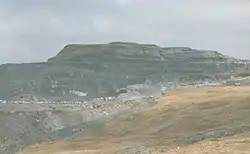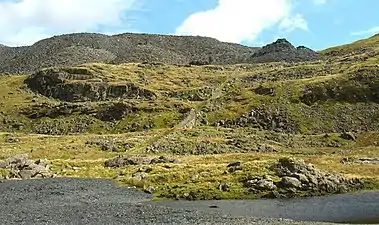Graig Ddu quarry
Graig Ddu quarry (also known as Craig Ddu quarry, Manod quarry, or, since the closure of the nearby Cwt y Bugail quarry, Cwt y Bugail quarry) is a disused slate quarry near Blaenau Ffestiniog (formerly Blaenau Festiniog), in Gwynedd (formerly Merioneth or Merionethshire), North Wales. Although output was only about 3,000 tons a year (3,140 tons in 1882), it reputedly has 36 saw tables and the same number of dressing machines on site. As with others in the area, the quarry suffered from a lack of water, resulting in the siting of the mill some distance away, at a lower level.[1]
 Graig Ddu quarry in 2004 | |
| Location | |
|---|---|
 Graig Ddu quarry Location in Gwynedd | |
| Location | near Blaenau Ffestiniog |
| County | Gwynedd |
| Country | Wales |
| Coordinates | 52.992259°N 3.899746°W (quarry) 52.991057°N 3.915171°W (slate works) |
| Production | |
| Products | Slate |
| Type | Quarry |
Bala & Festiniog Railway | |||||||||||||||||||||||||||||||||||||||||||||||||||||||||||||||||||||||||||||||||||||||||||||||||||||||||||||||||||||||||||||||||||||||||||||||||||||||||||||||||||||||||||||||||||||||||||||||||||||||||||||||||||||||||||||||||||||||||||||||||||||||||||||||||||||||||||||||||||||
|---|---|---|---|---|---|---|---|---|---|---|---|---|---|---|---|---|---|---|---|---|---|---|---|---|---|---|---|---|---|---|---|---|---|---|---|---|---|---|---|---|---|---|---|---|---|---|---|---|---|---|---|---|---|---|---|---|---|---|---|---|---|---|---|---|---|---|---|---|---|---|---|---|---|---|---|---|---|---|---|---|---|---|---|---|---|---|---|---|---|---|---|---|---|---|---|---|---|---|---|---|---|---|---|---|---|---|---|---|---|---|---|---|---|---|---|---|---|---|---|---|---|---|---|---|---|---|---|---|---|---|---|---|---|---|---|---|---|---|---|---|---|---|---|---|---|---|---|---|---|---|---|---|---|---|---|---|---|---|---|---|---|---|---|---|---|---|---|---|---|---|---|---|---|---|---|---|---|---|---|---|---|---|---|---|---|---|---|---|---|---|---|---|---|---|---|---|---|---|---|---|---|---|---|---|---|---|---|---|---|---|---|---|---|---|---|---|---|---|---|---|---|---|---|---|---|---|---|---|---|---|---|---|---|---|---|---|---|---|---|---|---|---|---|---|---|---|---|---|---|---|---|---|---|---|---|---|---|---|---|---|---|---|---|---|---|---|---|---|---|---|---|---|---|---|---|---|---|
| |||||||||||||||||||||||||||||||||||||||||||||||||||||||||||||||||||||||||||||||||||||||||||||||||||||||||||||||||||||||||||||||||||||||||||||||||||||||||||||||||||||||||||||||||||||||||||||||||||||||||||||||||||||||||||||||||||||||||||||||||||||||||||||||||||||||||||||||||||||
History
The quarry originally opened as Manod quarry in about 1800. In the 1840s, the Manod quarry moved northwards, and the new site was developed as Graig Ddu.
From around 1868, a three-pitch cable-worked incline was built down to the main road (a later tramway and fourth incline was used to connect to the local railway). These first three inclines were renowned for the quarrymen's use of ceir gwyllt (wild cars), a sort of skateboard which sat on one rail, with an arm reaching across to a parallel rail, an operation that was only possible at Graig ddu, of all the Blaenau quarries, because the exit incline from the mill level was both very long and of unusually shallow pitch—it ran across the face of the hillside to the east of Tanymanod, rather than directly up and down.[1]
This was one of the last quarries in the area to ship slate down the River Dwyryd, as it did not link to the Festiniog Railway when that opened in 1836. Instead, Craig Ddu quarry continued to ship slate via a packhorse to the Dwyryd until 1868, when the Festiniog and Blaenau Railway opened. This railway connected with the quarry inclines; its vastly improving the method of transporting slate from the quarry. After 1883, when this railway was converted to standard gauge, wagons were carried to Blaenau Ffestiniog, where they could be transferred to the Festiniog Railway or into GWR wagons for onward shipment, using a piggy-back style similar to that used on the Padarn Railway at Dinorwig quarry.[2]
Closure
Graig Ddu closed in 1939 at the outbreak of the Second World War. It re-opened briefly after the war to supply slates for rebuilding bomb-damaged cities.[3] The quarry employed 86 men when it closed in 1946.[1]
Modern operations
From the mid-1980s, modern quarrying operations at the site of the original Manod quarry extended over the summit of Manod Mawr and reached the derelict Graig Ddu quarry. Much of the quarry site has been obliterated by this untopping operation. Untopping at Graig Ddu ceased in 2007.[4]
Gallery
 The derelict slate storage area at Graig Ddu quarry
The derelict slate storage area at Graig Ddu quarry The upper incline at Graig Ddu
The upper incline at Graig Ddu.jpg.webp) Riding the "car gwyllt" in the Craig-ddu Quarry (1959)
Riding the "car gwyllt" in the Craig-ddu Quarry (1959)
References
- Boyd, James I.C. (1975) [1959]. The Festiniog Railway 1800 - 1974; Vol. 2 - Locomotives and Rolling Stock; Quarries and Branches: Rebirth 1954-74. The British Narrow Gauge Railway. Blandford: The Oakwood Press. ISBN 978-0-85361-168-4. OCLC 874117875. B1B.
- "Craig Ddu Quarry". The Narrow Gauge Railway Museum.
- Jenkins, Huw (11 April 2008). "Wild way home" (PDF). BBC News Wales.
- Sallery, Dave. "Manod / Welsh Slate's 'Cwt y Bugail Quarry': A brief history of the quarry".